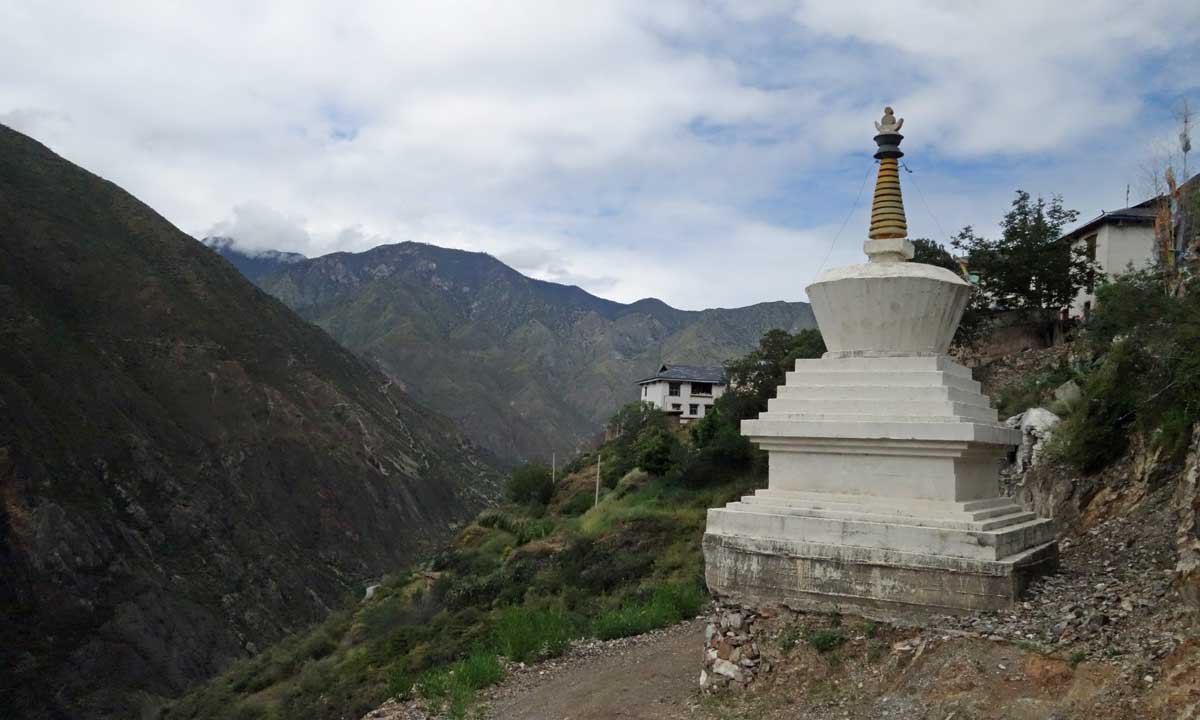Moving along the Ancient Tea-Horse-Road, I headed from Xianggelila (Shangri-la) in Yunnan further along the road towards Lhasa.
This led into the area of the “Three Parallel Rivers,” to the Jinsha river valley, which is what the Yangtze is called here in its upper reaches.
Even on this short day trip, it was just crazy interesting!

You can read all about my “discovery” of a perennially-growing golden chilli in/from Tibet over on ChiliCult, but I also wanted to give some more impressions of that area.
The area in question is around Nixi, which is no longer being visited by many tourists.
Shangri-la already had fewer visitors than I would have expected (and than Lijiang had), but Nixi would be much harder to reach, as well.
I only made it there – and only as a day trip – because my research into the chilli had me travelling with a Chinese colleague, in a car we had rented for that very purpose.
Thus, however, we went up along the Jinsha river, the river of “Golden Sand.”
Xinyangcun – Up the Mountain
First, we went in search of a place called Xinyangcun.
I had – how is that for modern times? – heard about it in a TV documentary as the place where that chile pepper was grown…
We did not have to search much for the village; our GPS navigation app led us there without too many issues.
Only, we didn’t exactly trust that the road it had us turn onto was really the road in question.
We were traveling on a major highway, and that was already a mountain road, meandering and with just a single lane in each direction.
Rock face on your right, the valley floor far below on the left.

Now, however, we had to turn off onto a road snaking further up the mountain, just wide enough for a single car.

If anybody had come in the other direction, we had no idea what we would have done. But that view!

In the little village, which turned out to not be the home of that golden chile pepper, an agricultural station was just being built – as one can easily tell from the photo above.
Along the Road to Lhasa
Down, back on the highway, following its course far above the Jinsha River, we found a viewing platform we just had to stop at…

Eventually, we also found one place where the chilli I had been searching for was indeed growing. And it was a fascinating landscape!

Kaizhongshui, Where Golden Chilli Grows
The steep mountain slope falls from the ridge to the Jinsha river far below.
There is little flat ground, which a few houses, scattered here and there, use.
Some paths exist, but they are just barely wide enough for a car. At least they connect the highway to Lhasa and the houses – but could you even call this a village?
Farther away still, which also means quite a scramble down (and back up again), there were fields.
Corn was recognizable, pumpkins… and chilli?



How anyone could possibly make a living there is hard to fathom. But people live there, and they were nice.

My Chinese colleague had just about as many issues communicating as I had; the people we met almost only spoke Tibetan. They were still welcoming, and I was able to find the chilli I was looking for – and more.
But, among the plants growing there was also quite a bit of a mugwort… which was in full bloom.
Just the kind of mugwort which I am quite allergic to. That part, I could have done without; I was sneezing and sniffling and increasingly getting in trouble with my eyes.
That, too, can be a part of going into the world for microexploration…
The area was fantastic to see, anyways – and there’s one more thing one should know about this part of China…
Tough Life – Long History of Settlement
Far away from anything and hard to eke out a living as it is, the region does not exactly seem like anywhere that people should have been living for long.
Nixi, however, is where some of the oldest pottery tradition in China can be found.
Nixi Tibetan black pottery is still being made – or rather, has been revitalized in recent decades and declared a national cultural heritage.
Its tradition goes back at least 1200 years.
Out of this world – and A WeChat Away
Now, you only need to travel here on the highway to come past shops selling such wares – and while you do, imagine living here, now or more than a thousand years ago, making pots and growing crops and vegetables (and probably, herding some yaks) for your subsistence.
The environments that humans can live in!
And how strange it is, nowadays.
On the one hand, such an interesting kind of produce as this golden chilli is basically non-existent in any public record.
Even on the seemingly almighty world wide web, there is nary a trace of it.
On the other hand, people have started to try and market it – and they can be reached by smartphone messenger app Wechat; they are just a message away!



Leave a Reply